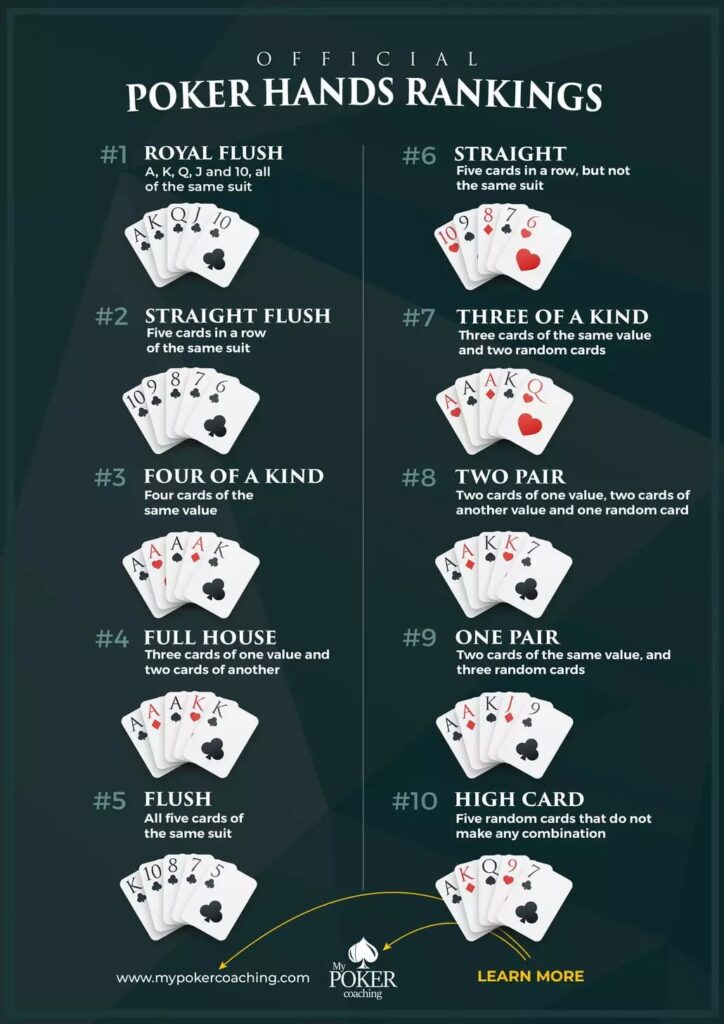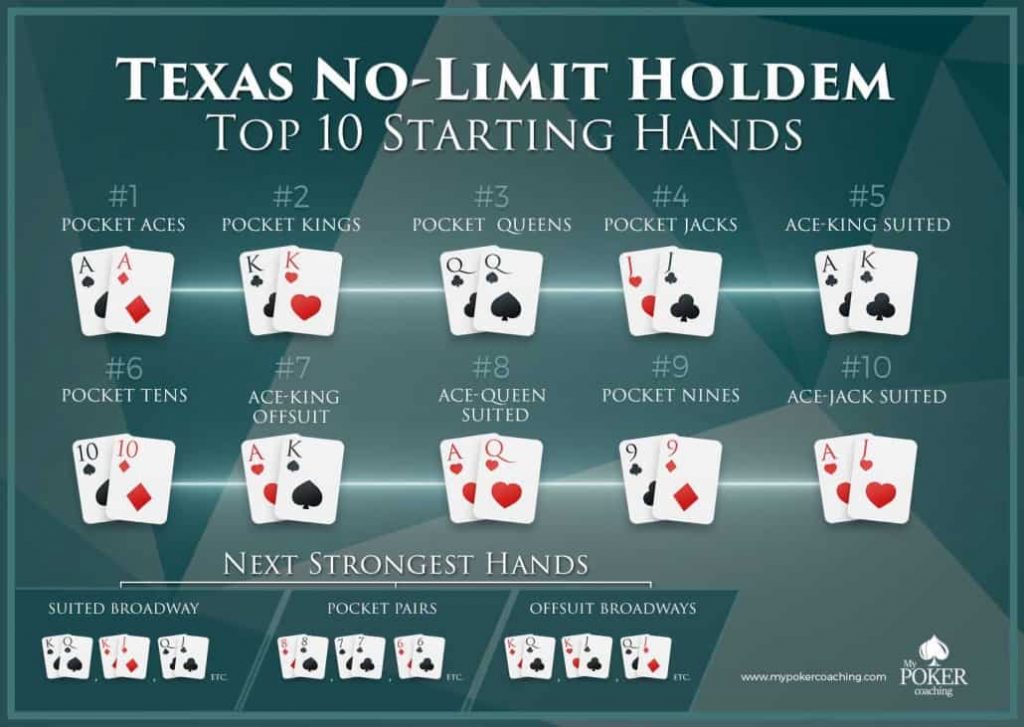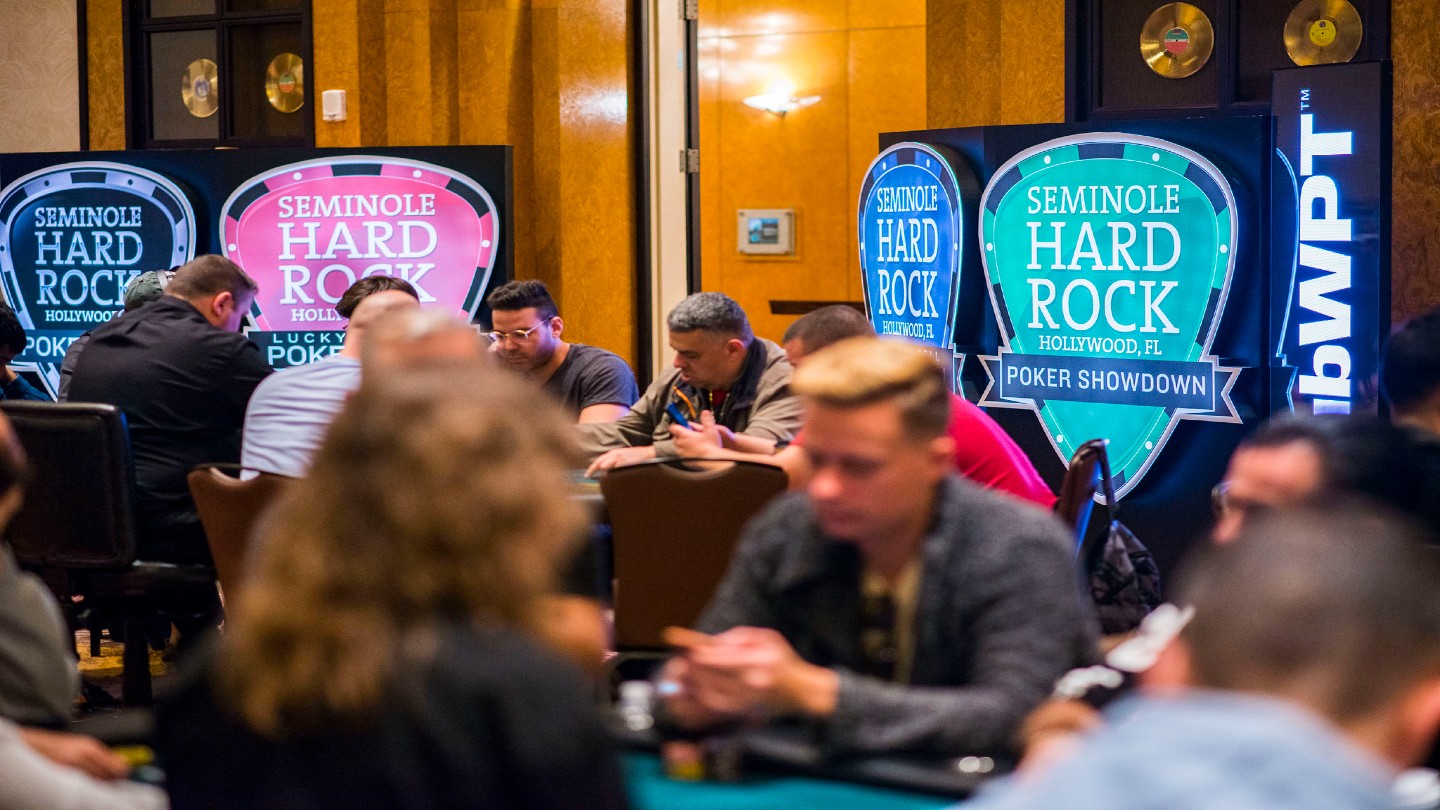Best Poker Hands – Texas Holdem Poker Hand Rankings (PDF)
There are ten different poker hand combinations in Texas Holdem, and you need to know what beats what in every situation to play the game. Therefore, always remember this list of poker hands in order from strongest to weakest.
The best poker hand is Royal Flush, followed by Straight Flush, Four of a Kind, Full House, Flush, Straight, Three of a Kind, Two Pair, One Pair, and lastly High-Card poker combination.
To make it easier to remember, we put together a downloadable PDF of the official poker hand rankings so you can print it out and always have it on hand until you know what beats what in poker by heart.

Download Poker Hands Printable PDF
It is essential to remember that each poker hand is ranked based on the best possible five-card combination.
We also made a video for you with a professional poker player, Tristan Wade, going over the Texas Hold'em hand rankings so you can see how it works in practice.
Let’s dive into a couple of examples so you better understand what each poker hand is made of and see why they are ranked in this particular order.
Texas Holdem Poker Hand Rankings In Order
#1. Royal Flush

Royal Flush is the best possible poker hand containing cards from Ten to Ace all of the same suit.
For example, if you have A♥K♥ and the board comes J♥Q♥6♠5♣10♥, you just made the Royal Flush, which is the best possible poker hand.
Royal Flush beats all other hands in poker, so you are guaranteed to win a pot whenever you have this holding in the Texas Holdem game.
Learn more about the Royal Flush.
#2. Straight Flush

Straight Flush is the second-strongest poker hand in Texas Hold’em that contains five cards of the same suit in a row.
For example, if you have 9♠8♠ and the flop comes 10♠7♠2♥6♠A♦, you made your Straight Flush, which is the best poker combination you can have in this situation.
Straight Flush beats four-of-a-kind, full-house, flush, and all other Texas Hold’em hands except the Royal Flush.
Learn more about the Straight Flush.
#3. Four of a Kind

Four of a Kind is a hand consisting of four cards of the same value and ranks third in the official poker hand rankings. This hand combination is also known as “quads.”
For example, if you have A♥A♠ for pocket kinds and the board runs as A♦Q♠6♣A♣2♠, you made quad aces, which is the strongest Four of a Kind hand in Texas Holdem.
Four of a Kind beats full-house, flush, straight, and all other lower poker hand combinations in the Texas Hold’em hands order list. This hand only loses to the Royal Flush and the Straight Flush.
Learn more about the Four of a Kind.
#4. Full House

Full House is a poker hand made of three cards of the same rank and a pair, making it rank 4th in the order of strongest poker hands.
For example, if you hold A♥J♠ and the board runs as A♦10♠J♦A♣2♠, you made the Full House – Aces full of Jacks.
Full House beats flush, straight, trips, and other lower-ranked combinations in official poker hand rankings and loses only to Royal Flush, Straight Flush, and Four of a Kind.
Learn more about the Full House.
#5. Flush

Flush is a poker hand made of five non-consecutive cards of the same suit.
For example, if you are holding A♠7♠ and the board runs as [invalid notations], you made an ace-high flush combination.
Flush beats straight, trips, two pairs, one pair, and high-card combinations but loses to Royal Flush, Straight Flush, Four of a Kind, and a Full-House.
Learn more about the Flush.
#6. Straight

Straight is a poker hand consisting of five cards in a row that are not all of the same suit.
For example, if you are holding J♠10♦ and the board runs as 9♥8♣7♠A♦3♥, you made jack-high straight.
Straight is the 6th strongest poker hand in order and beats Three of a Kind, two pairs, one pair, and a high card. At the same time, Straight loses to better Texas Holdem hands, such as Royal Flush, Straight Flush, Four of a Kind, Full House, and Flush.
Learn more about the Straight.
#7. Three of a Kind

Three of a Kind poker hands consist of three cards of the same rank and two unmatching cards.
For example, if you are holding J♠J♣ and the board runs as J♦7♠3♥4♣K♦, you just made Three of a Kind Jacks, also known as a set in this situation.
Three of a kind is the 7th strongest poker hand in order and beats Two Pairs, One Pair, and a High Card. Straight loses to all other official poker hand combinations sitting above it, namely Royal Flush, Straight Flush, Four of a Kind, Full House, Flush, and a Straight.
Learn more about the Three of a Kind.
#8. Two Pair

A Two Pair poker hand consists of two cards of one rank, another two cards of different rank, and another unmatching card. To put it short, this poker hand combination is made of two different pairs.
For example, if you are holding A♣J♦ and the board runs as A♥J♠9♣5♦3♥, you made a Two Pair hand consisting of a pair of aces and a pair of jacks.
In the list of strongest poker hands, the Two Pair combination is only 8th in Texas Hold’em, but it beats One Pair and High Card. However, it loses to Royal Flush, Straight Flush, Four of a Kind, Full House, Flush, Straight, and Three of a Kind.
Learn more about the Two Pair.
#9. One Pair

One Pair poker hand is made of two cards of the same rank and three unmatching cards.
For example, if you are holding A♣8♠ and the board runs as A♥J♦7♠4♣3♥, you have a One Pair poker hand.
In the Texas Hold’em poker hand rankings, the One Pair stands in 9th place and only beats a High Card. It loses to all other poker hand combinations, including Royal Flush, Straight Flush, Four of a Kind, Full House, Flush, Straight, Three of a Kind, and Two Pair hands.
Learn more about the One Pair.
#10. High Card

High Card is a poker hand combination of five unmatching cards.
For example, if you are holding A♠J♦ and the board runs as 10♠8♣7♠4♦3♥, you have a High Card poker hand, meaning that you did not make any ranked hand or hit one of the previously mentioned combinations.
High Card is the lowest ranked poker hand and does not bean any other combinations in Texas Hold’em.
Learn more about the High Card.
Poker Hands Ranking Rules and The Kicker
There are a few situations where players can have a similar holding, but you still need to decide the winner of a particular poker hand. If two players have one pair hands, the one holding a higher pair will win.
KKxxx will always win against JJxxx and so on.
However, sometimes players end up having the same pair, such as KKQT3 and KKJ72. In this case, “the kicker” comes into play, and the player holding the highest non-pair hand will win.
Therefore, a poker hand with A♥K♠Q♣10♦3♠ will take down the pot because it has a higher kicker (Q>J).
If the top non-pair card is the same (like K♥ K♠ Q♣ T♦ 3♠ vs. K♥ K♠ Q♣ 9♥ 4♥), then you have to compare the second high card and if that is the same, then the third one. The pot will be split if all five cards are the same and both players end up having the identical combination.
It could happen with two pair hands as well. If players have JJ55K and JJ55Q, the one holding a king as a kicker will take down this pot.
Few other poker hand rankings rules:
- When both players have two pairs, the winner is the one holding the highest pair. If the highest pair is the same, then you have to compare the lower pair, and if that is the same as well, then the kicker decides (JJ227 wins against TT998)
- When both players have a flush, the winner is the one who holds a higher one (KhQh8h6h3h wins against KsQs7s4s3s)
- When both players have a straight, the winner is the one who holds the higher card combination (QJT98 wins against T9876)
- When both players have full houses, the winner is one who holds higher 3-cards of the same rank (77722 wins against 666AA)
- When both players have nothing, the winner is the one holding the highest card. If the highest card is the same, then you have to compare the second one and so on until you find the difference (AQJ85 wins against AQJ83)
Top 10 Best Starting Poker Hands In Texas Holdem

Download the full-resolution picture for later use!
If you ever get lost what are the best poker hands to play, just refer to this starting poker hands list, and you should be good. Here are the top 10 starting hands in Texas Holdem:
- # 1. Pocket Aces (AA) – Pocket Aces are by far the best starting poker hand in Texas Holdem and a big favorite to win, no matter what other players have.
- #2. Pocket Kings (KK) – Pocket Kings is the second strongest poker hand, having a significant edge over other players in all situations, so you should always be ready to risk your stack with this hand.
- #3. Pocket Queens (QQ) – Pocket Queens is the third strongest starting hand in poker and had great odds before the flop against any range.
- #4. Pocket Jacks (JJ) – Pocket Jacks are a bit more tricky to play postflop if you see overcards, so it is usually best to play it fast and put money into the pot even before community cards are dealt.
- #5. Ace-King Suited (AKs) – Ace King suited is a powerhouse and sits in 5th place as the best starting hand in Texas Hold'em. Most of the time you will dominate your opponents and be flipping against other pairs, so that is the hand you want to have.
- #6. Pocket Tens (TT) – Pocket Tens is also a very powerful hand, sitting at 6th place on the best poker hands list. It has a lot of equity against lower pairs and unpaired hands, so you should be looking to play this hand in almost all situations.
- #7. Ace-King Offsuit (AKo) – Ace King offsuit is also an extremely strong hand because it reduces the likelihood of your opponents having pocket aces or pocket kinds, and you are in great shape against all other hands.
- #8. Ace-Queen Suited (AQs) – Ace Queen suited is a very strong hand in Texas Hold'em that will help you win big pots when flopping strong top pairs.
- #9. Pocket Nines (99) – pocket nines are not as strong as other pairs in this list, but it is a perfect hand to raise yourself or call a raise from your opponent and see the flop.
- #10. Ace Jack Suited (AJs) – Ace Jack suited will help you win big pots when you hit your flush or flop strong pairs, but that is a hand that AK or AQ can also dominate, so you should not take it too far before the flop.
Choosing the right hands preflop is one of the most important things when starting out, and it can have a huge impact on your win rate.
Other good poker hands to play include Broadway hands like KQ, KJ, and QJ, which will help you win big pots when you dominate your opponent's weaker holdings or when you hit your flush with suited ones.
On top of that, you should usually play small pocket pairs like 88, 77, 66, 55. These hands will book massive wins after hitting a set since it is well disguised, and your opponent rarely expects you to have trips when they also hit something good.
Do yourself a favor, do not play unreasonable holdings, and concentrate on getting maximum EV with your best poker hands.
Read the full articles and learn more about the Best Starting Hands in Poker.
Poker Hand Rankings FAQ
What is the best hand in poker?
The absolutely best hand, according to the official poker rules, is the Royal Flush, which is made of Ace, King, Queen, Jack, and Ten, and all of those must be the same suit.
For Example, Ah Kh Qh Jh Th would make a Royal Flush hand and is unbeatable by any other combination. If you are lucky enough to hit a Royal Flush, you will surely win this poker hand, no matter what other players have.
What beats what in poker?
You can find poker hand rankings in order at the start of the article, but to make this simple, here is a list of what beats what in poker:
- One Pair beats a High Card, no matter what it is.
- Two Pair beats One Pair hand.
- Three of a Kind always beats Two Pairs.
- A Straight beats Three of a Kind
- A Flush always beats a Straight, no matter how low or high it is.
- A Full House beats a Flush.
- A Four of a Kind (Quads) beats a Full House.
- A Straight Flush beats Four of a Kind.
- Royal Flush beats Straight Flush, and every other poker hand there is.
So if you want to quickly check what beats what in poker, refer to this list, and you will see if you have a winner.
What is the highest suit in poker?
Every suit has the same value in Texas Holdem games, so it does not matter if you are holding Spades, Hearts, Diamonds, or Clubs, it does not determine your poker hand's strength.
The most important factor is your poker hand strength, according to poker hand ranking, and nothing else matters for the most part.
P.S. – Some rare games do rank suits, and if you happen to find one of those, you will most likely see suits ranked in this order:
- Spades being the highest suit
- Hearts following in second place
- Diamonds ranking in the third
- Clubs being the lowest value suit
These games are very rare and not popular, so you probably will not find it running. That said, these rules can be used to determine who has to post blinds or antes in some poker variations.
How many different poker hands you can have?
If you are wondering about made poker hands, there are only ten different options that are covered in poker hands ranking. Here is the poker hands list in order:
- Royal Flush
- Straight Flush
- Four of a Kind
- Full House
- Flush
- Straight
- Three of a Kind
- Two Pair
- One Pair
- High Card
However, there are 1,326 different starting poker hands in Texas Holdem and even 270,725 poker hand variations in Pot Limit Omaha.
While there are many different starting hand options in various games, the winning hand is determined by poker hand rankings consisting only of 10 options.
When is the kicker used to determine the winning poker hand?
Simply put, the kicker is used to determine a winner in a situation where two players have the same hand at the showdown. Most often used with One Pair and Two Pair poker hands.
It is best to illustrate this with an example.
If both players have One Pair hand, the one holding the highest pair wins, it as simple as that. But what if they both have the same pair? Well, then the kicker comes into play.
Player A holds: 9 9 K 7 6
Player B holds: 9 9 Q J T
Since Player A's highest card is a King and Player’s B highest card is a Queen, the first player wins because he has a higher kicker.
If both have the same highest card, then the second card is compared to determine the winner.







